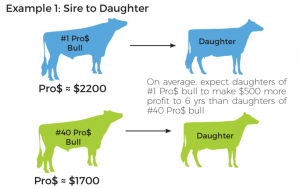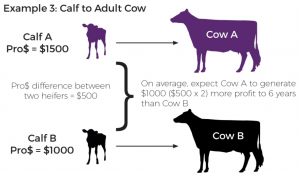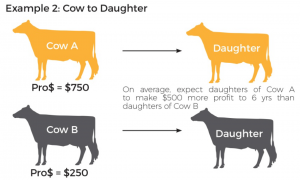Pro$ was introduced in August 2015 as a new national genetic selection index in the Holstein and Jersey breeds, in addition to a modified LPI formula. A.I. organizations, breed associations and other industry organizations have embraced this new index that targets producers that earn essentially all of their farm revenue from milk sales. So far, extension has focused on interpreting sire Pro$ values. But what about females? Canadian Dairy Network (CDN) also calculates and publishes Pro$ values for cows and heifers. Learn how they can be used in your breeding program.
 Pro$ for Sires
Pro$ for Sires
Pro$ ranks bulls based on the expected average accumulated profit their daughters will achieve until they reach six years of age. There are various ways for sires to achieve high Pro$ values and rankings depending on the ability of their daughters to produce and reproduce well over multiple lactations and experience fewer problems that would otherwise increase herd expenses.
When developing the Pro$ index, CDN felt it was important that the Pro$ difference between sires was directly related to the extra lifetime profit to six years that the daughters would generate for Canadian producers. For this reason, the scale used for Pro$ is specifically in Canadian dollars.
Let’s look at an example with the current #1 proven sire compared to the #40 proven sire for Pro$. The #1 sire has a Pro$ of $2200 while the #40 sire has a Pro$ of $1700. This means that, on average, daughters of the #1 sire are expected to generate about $500 more profit per daughter over their lifetime up to six years of age (Example 1). The take home message here is that sire Pro$ values directly represent the average difference in profit that their daughters are expected to earn up to the age of six years.
 Pro$ for Females
Pro$ for Females
On the female side, Pro$ can be used in two distinct ways. On one hand, Pro$ values for cows can be interpreted in the same way as described above for sires. In this context, you must compare Pro$ values between two or more cows and these differences will directly reflect the expected difference in lifetime profit that future replacement heifers, daughters of those cows, would generate for your herd (Example 2). In your herd, your highest Pro$ cows, based on their genetic evaluations for production, conformation and functional traits, will have values that are hundreds of dollars higher than the average of your herd. These cows, on average, are expected to produce the most profitable replacement heifers for your herd.

Animal’s Transmitting Ability Versus Genetic Merit
While it may seem confusing to interpret Pro$ values differently for cows compared to heifers, you simply need to remember why you are using Pro$. When selecting sires or comparing Pro$ among cows in your herd, your focus is producing the most profitable replacement heifers possible. Since the primary use of Pro$ is for sire selection, it has been expressed in a manner that represents the genetics that the animal, sire or cow, is expected to transmit to its progeny, on average. In this way, Pro$ values are considered as the animal’s “Transmitting Ability”.
When considering Pro$ values among a group of young heifers, the objective is to get a better understanding of each heifer’s own “Genetic Merit”, which means doubling the Pro$ values that are expressed as a Transmitting Ability. Doubling Pro$ values for heifers represents how they are expected to perform, on average, as cows in a herd with typical management. Actual lifetime profit realized by each animal can clearly be different due to the significant impact of herd management levels and other non-genetic factors that can affect a cow’s expression for production, conformation and functional traits.
Summary
Pro$ is a selection index that allows producers to improve the lifetime profitability of the dairy herd. The scale of expression for Pro$ values allows direct comparison between sires to easily understand the expected differences in profit of their daughters. This is also true when comparing Pro$ for cows since differences reflect the average lifetime profit their daughters are expected to achieve as future replacements. Since Pro$ is expressed as a “Transmitting Ability”, the values need to be used differently when comparing among a group of heifers. In this case differences need to be doubled in order to serve as a prediction of differences in their future accumulated profit in a herd with typical management.
Source: Canadian Dairy Network







 Pro$ for Females
Pro$ for Females



